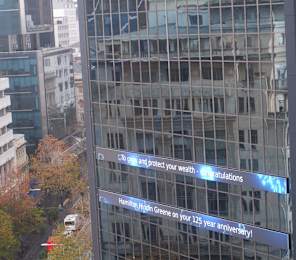New Zealand shares snapped a three-day decline as the economy returned to life after a protracted downturn, stoking optimism that lower interest rates have started generating more activity this year.
The S&P/NZX 50 index edged up 8.79 points, or 0.1%, to 12,12,054.72. Trading was busy with a turnover of $256.5 million across the main board, with Auckland International Airport accounting for $27.7 million as it fell 0.8% to $7.82.
New Zealand’s economy grew 0.7% in the December quarter, beating economists’ expectations, with Statistics New Zealand figures showing the first expansion on a per capita basis since mid-2022.
“That’s something to be happy about and hopefully it sets us up for a more solid 2025,” said Mark Lister, investment director at Craigs Investment Partners. “I don’t think it changes much for the Reserve Bank, which should still cut next month.”
The kiwi traded at 57.96 US cents at 5pm in Auckland from 58.12 cents yesterday, losing some of its lustre after the US Federal Reserve kept open the prospect of further interest rate cuts as it waits to see the impact of President Donald Trump’s tariff programme.
Wall Street rallied on the Fed’s decision and stock markets across Asia were mixed, with Australia’s S&P/ASX index up 1.1% in late trading, while Hong Kong’s Hang Seng fell 1.2% and Japan’s Nikkei 225 was up 0.3%.
Mercury NZ led the local benchmark index higher, rising 3.8% to $5.71. The electricity generator-retailers were mixed as low hydro lake levels and weak inflows have some investors pondering whether there’ll be a repeat of last year’s winter energy squeeze.
Meridian Energy increased 1.5% to $5.40, while Contact Energy decreased 0.2% to $8.50 and Genesis Energy slipped 0.9% to $2.15.
Rain wanted
Craigs’ Lister said that’s trade-off to renewable energy.
“It’s not unusual for the industry to deal with it and while it’s negative in the short-term, there are winners and losers,” he said. “Most investors are still feeling quite comfortable with the major players in that sector.”
Fonterra Shareholders’ Fund units advanced 1.2% after the dairy cooperative hiked its interim dividend to 22 cents from 15 cents a year earlier, on an 8% increase in first-half profit.
Synlait Milk increased 3.1% to $1, while The a2 Milk Co, which shed rights to its maiden dividend of 8.5 cents, declined 0.9%, or 8 cents, to $9.16.
Channel Infrastructure fell 2.6% to $1.87 after Ampol-owned Z Energy sold its 13% stake in the import terminal operator, holding above the $1.84 price the shares were sold at through a bookbuild run by Macquarie.
Spark New Zealand posted the biggest decline as it shed rights to a 12.5 cents dividend, falling 5.5%, or 11.5 cents, to a 13-year low $1.96. The telecommunications company was the most heavily traded stock on a volume of 5.3 million.
Infratil fell 2.2% to $10.27.
Warehouse Group fell 3.8% to 82 cents ahead of its first-half result on Friday, which is expected to show tough trading conditions through the tailend of last year.
Would-be miner Santana Minerals rose 4% to 64.5 cents after applying for its mining permit, while New Talisman Gold Mines jumped 15%, or 0.7 of a cent, to 5.4 cents after saying it will take more time trialling its recently purchased ore processing equipment.
Reporting by Paul McBeth. Image from Curious News.










